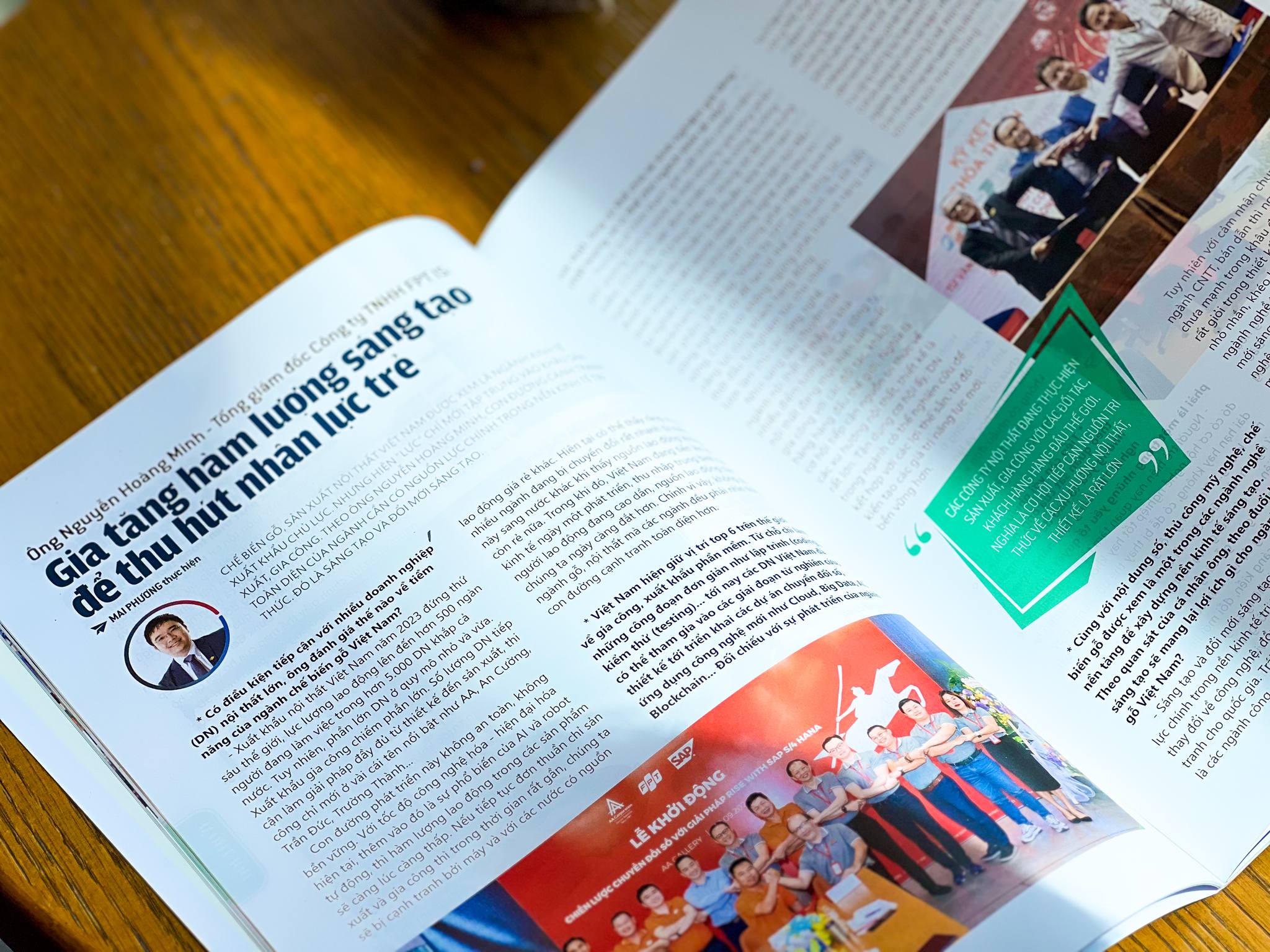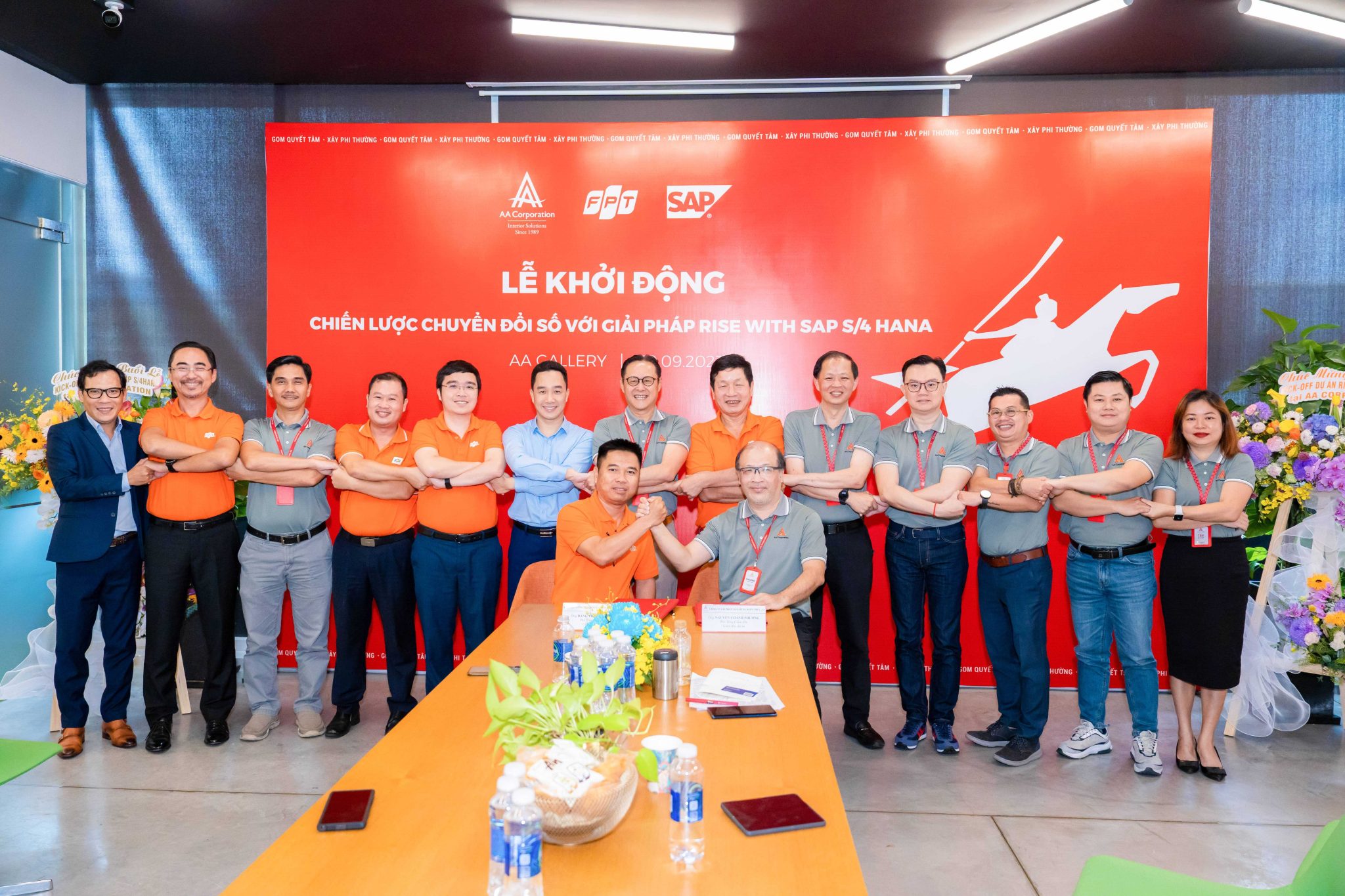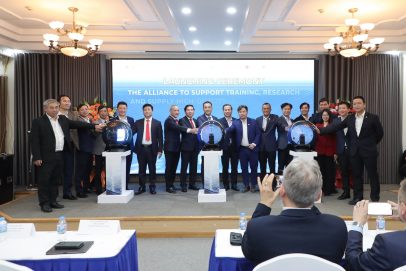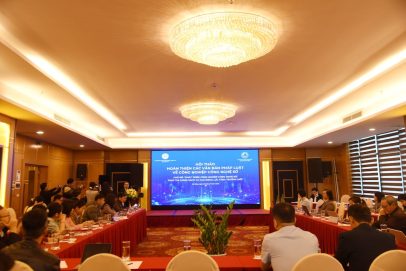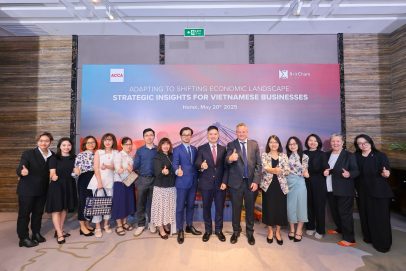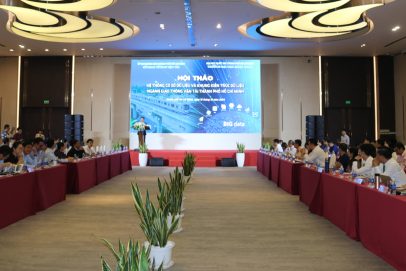CEO of FPT IS spoke with the Wood and Furniture Magazine: “Increasing creativity to attract young talents”
In a recent interview with Wood and Furniture Magazine, a publication of the Handicraft and Wood Industry Association of Ho Chi Minh City (HAWA), the Chief Executive Officer of FPT IS Nguyen Hoang Minh discussed the potential of Vietnam’s wood processing industry. He highlighted the experience of elevating the industry’s position and quality through the power of technology, and identified key factors that foster innovation and the development of human resources in this crucial economic sector.
The Chief Executive Officer of FPT IS Nguyen Hoang Minh shared in the Wood and Furniture Magazine issue 98
The interview details are below:
Wood processing and furniture production in Vietnam are considered key export sectors. However, the currently resource is only focused on production and processing. According to Mr. Nguyen Hoang Minh, creativity and innovation, the two primary resources in the knowledge economy, are essential for the industry to reach full competitiveness.
Reporter: With access to many big furniture companies, what potential do you see in Vietnam’s wood processing sector?
Mr. Nguyen Hoang Minh: In 2023, Vietnam ranked as the sixth largest furniture exporter in the world, employing over 500,000 people in over 5,000 companies across the country. However, most businesses are small to medium-sized enterprises focused primarily on processing exports. Only a few well-known companies, such as AA, An Cuong, Tran Duc, and Truong Thanh, use comprehensive solutions from design to production. This is not a sustainable or safe development path. With the current rate of modernization and technology advancement, in addition to the popularity of AI and automated robots, the labor-intensity products will continue to decline. Continued reliance on production and processing means, we will soon be competing with machines and countries with cheaper labor. It can be seen that many industries are shifting rapidly from one country to another when the labor source is no longer cheap. Vietnam’s rising economy and increasing average salaries necessitate a more holistic approach to competitiveness across all industries, not just wood and furniture.
Reporter: Vietnam is currently ranked sixth in the world in software outsourcing and export. Vietnamese enterprises are no longer limited to performing basic tasks like testing or coding; instead, they can now take part in all stages of digital transformation projects, from research and design to implementation and application of new technologies like Cloud, Big Data, AI, and Blockchain. In relation to the growth of the furniture industry, could you please share your experience in enhancing the furniture industry’s position and quality?
Mr. Nguyen Hoang Minh: While participating in software export, FPT positions itself as a global technology company, not just a software outsourcing firm. We have created standards, regulations, and processes that comply with world-class standards, and invested continuously in researching and mastering new technologies like AI, Blockchain, Big Data, etc. In addition, FPT uses its core technology competencies to build a “Made by FPT” product and solution ecosystem that creates long-term, sustainable competitive advantages. We constantly develop and enhance our capacity with customers while making significant investments in the strategy of mastering technologies.
Similarly, furniture companies are manufacturing and processing for the world’s leading partners and customers. This might lead to a great chance to gain knowledge about furniture and interior design trends. Taking advantage of that opportunity, businesses in the industry can research to combine existing advantages, thereby creating new, more sustainable capacity values.
FPT has made continuous investments in researching and mastering new technologies like AI, Blockchain, Big Data, etc.
Reporter: Together with digital content and handicrafts, wood processing is considered one of the foundational industries to build a creative economy. What advantages do you personally see for the Vietnamese wood processing industry in pursuing a creative economy?
Mr. Nguyen Hoang Minh: Creativity and innovation are considered the two primary resources in the knowledge economy, driving to technology changes and giving nation a competitive edge. The heart of the creative economy consists of highly innovative industries including design, architecture, handicrafts, and wood processing.
In 2021, Vietnam moved up two places in Bloomberg’s list of innovative economies, but it was still ranked 55th out of 60 nations. Compared to Singapore, which is ranked second, Malaysia, ranked 26th, and Thailand, ranked 36th, we still have a long way to go. In the Global Innovation Index (GII) 2023, among the 132 countries and territories, we moved up two places but still stayed at 46th. In the broader picture, the handicraft and wood processing industries currently hold an insignificant place in the world.
However, based on my general perception and experience in the IT industry, regarding the semiconductor industry, Vietnamese individuals and companies may not be strong in generating ideas or concepts, they are very skilled in detailed design. In my opinion, with the support of skilled craftsmanship that has proven successful in many craft industries, plus a connection in innovation, the wood processing and handicraft industries will improve their position in the creative economy.
One crucial connection is continuous or lifelong education and training, along with the application of advanced and digital technologies to the entire value chain of the wood processing and handicraft industries. This approach equips the existing and future workforce of the industry with knowledge and capacity for innovation, enabling them to participate in the digitized supply chain, also known as the digital supply network. It creates an interconnected space unrestricted by geography, thereby establishing a stronger and more global foundation for the industry’s future growth.
Reporter: In 2003, Vietnam’s software industry was in its first stage of development, employing roughly 5,000 people. By 2022, Vietnam’s software and IT services generated around USD 9 billion in revenue, with over USD 3.7 billion coming from software exports. There are currently over 300,000 employees working in Vietnam’s IT sector. In your opinion, what is the main driver of the industry’s high-quality workforce, aside from the trend factor? Unlike IT, which draws young talents easily, Vietnam’s furniture business is in need of human resources, particularly senior ones. What are the reasons, in your opinion?
Mr. Nguyen Hoang Minh: In my opinion, several factors have contributed to the software industry’s success in the context of export and globalization: First, it comes from the strong IT directions and policies of the government on IT. Second, it is the leadership and pioneering of several large domestic corporations, such FPT and CMC. Third, the leadership of professional associations like VINASA aids in resource centralization. Additionally, attracting young people through communication initiatives, building high-quality human resources, and focusing on training are all equally crucial.
Since the 2000s, the government and Ministry of Education and Training have launched communication campaigns, including the Vietnam Intelligence Contest, Robocon, and numerous other corporate communication programs. These efforts have created an appealing image that attracts both parents and young people. The training system has been built with many components offering training at various educational levels. Additionally, it is essential to mention about the business and sales efforts of companies, continuously creating many job opportunities both domestically and internationally, thereby promoting the development of a high-quality workforce.
While the IT sector has established a distinct identity, the wood sector has yet to leave a lasting impression in the minds of Vietnamese people. Personally, if I had not had the chance to talk with businesses in the industry, I would not have a clear impression of the accomplishments achieved by the industry. In fact, Vietnam’s wood industry has very impressive stories, with double-digit growth in wood and wood product exports for many years. Millions of exquisite interior products in world-famous hotel chains and buildings are made Vietnamese artisans. Undoubtedly, these stories can surely spark interesting industry-related communication topics.
However, the leading brands in the industry have not yet established a clear image, and have not created demand or significant influence in society. The demand for education and employment cannot be sufficiently raised in the absence of influence. As a result, not many organizations have taken part in training and advancement. These factors create a circle that is difficult to break.
Reporter: As you meet many young people, from your observations, what factors do they consider when selecting a major or profession? Are activeness and creativity among the decisive factors?
Mr. Nguyen Hoang Minh: These days, young people are concerned about whether a given occupation offers good career opportunities, whether it has a long-term prospect, or whether it is easily to be replaced by AI or machines. All industries require creativity and activeness, and businesses themselves must constantly engage in creative and innovative initiatives. Even the wood industry can project an image of creativity and activeness. For instance, they can organize continuous initiatives and innovation programs throughout the year to acknowledge and encourage creativity in all forms, from small to large.
Even workers can also continuously innovate in each stage of their everyday work. If you know how to utilize and exploit it, the wood industry will gain a lot of new values, continuously foster creativity in the industry, and become more attractive to young, talented resources.
FPT and AA Corporation cooperate to deploy the RISE WITH SAP S/4 HANA solution.
Reporter: As a unit assisting wood businesses in their digital transformation and IT applications, how do you evaluate the technology application capacity and level of modernization of the industry?
Mr. Nguyen Hoang Minh: Currently, the majority of those employed in the wood industry, including factory workers, are quite young, have early access to technology, and can fully meet all IT operation and application requirements. Vietnamese wood processing enterprises carry out all stages from raw material production to design and manufacturing, making their management system very complex. Technology can fully assist enterprises in management, as opposed to the current manual management and lack of administrative data. This is the reason behind extended production times, high costs, high error rates, and prolonged problem resolution. If businesses in the industry are determined to apply IT, they can not only transform their management methods and improve the skills of their current workforce, but also create an attractive new image that draws in new talent.
Along with digital transformation, green transformation will also pose big challenges for wood processing enterprises. Currently, not many businesses are ready to meet international NetZero standards, while the demands and standards purchasing green products are becoming increasingly stringent. As one of the leading countries in wood and forest product processing, Vietnam’s policies are moving towards a sustainable forestry industry that meets market requirements, including green finance and carbon market. Businesses who are well-prepared for this will soon acquire a competitive edge, strengthen their position, create job opportunities, and draw in new prospects.
Reporter: Finally, what do businesses need to do to promote the youth and creativity of the Vietnamese young generation in the corporate environment beyond just attracting them?
Mr. Nguyen Hoang Minh: Businesses need to aspire to expand their brands internationally. This will create a sufficiently large business environment that teaches both the businesses and their resources how to mature. It will also greatly attract young people who have a desire to explore the world and expand their career opportunities without limits.
Thank you!
Interviewed by Mai Phuong – the Wood and Furniture Magazine.
| FPT IS, a member of FPT Corporation, is currently a comprehensive technology partner of enterprises and organizations both domestically and internationally. In the wood industry, FPT IS is proud to be the unit that consults and deploys digital management platforms for leading businesses such as AA Corporation, Tran Duc, Truong Thanh, An Cuong, etc., assisting them in having a data-driven management system and making timely and effective decisions. FPT IS wishes to continue accompanying businesses in solving management challenges, and transforming technology into a core competitive advantage. |
From the Wood and Furniture Magazine: https://hawa.vn/tap-chi-go-noi-that/


